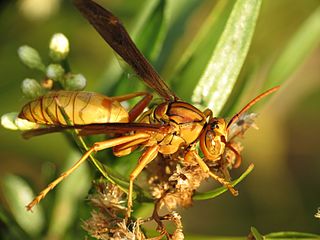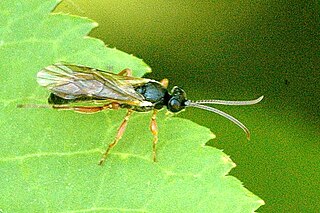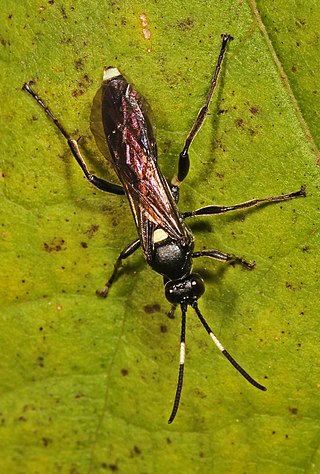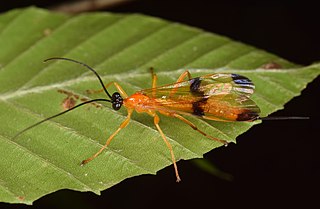
In evolutionary ecology, a parasitoid is an organism that lives in close association with its host at the host's expense, eventually resulting in the death of the host. Parasitoidism is one of six major evolutionary strategies within parasitism, distinguished by the fatal prognosis for the host, which makes the strategy close to predation.

The superfamily Ichneumonoidea contains one extinct and three extant families, including the two largest families within Hymenoptera: Ichneumonidae and Braconidae. The group is thought to contain as many as 100,000 species, many of which have not yet been described. Like other parasitoid wasps, they were long placed in the "Parasitica", variously considered as an infraorder or an unranked clade, now known to be paraphyletic.

The Ichneumonidae, also known as ichneumon wasps, ichneumonid wasps, ichneumonids, or Darwin wasps, are a family of parasitoid wasps of the insect order Hymenoptera. They are one of the most diverse groups within the Hymenoptera with roughly 25,000 species described as of 2016. However, this likely represents less than a quarter of their true richness as reliable estimates are lacking, along with much of the most basic knowledge about their ecology, distribution, and evolution. It is estimated that there are more species in this family than there are species of birds and mammals combined. Ichneumonid wasps, with very few exceptions, attack the immature stages of holometabolous insects and spiders, eventually killing their hosts. They play an important role as regulators of insect populations, both in natural and semi-natural systems, making them promising agents for biological control.

The Braconidae are a family of parasitoid wasps. After the closely related Ichneumonidae, braconids make up the second-largest family in the order Hymenoptera, with about 17,000 recognized species and many thousands more undescribed. One analysis estimated a total between 30,000 and 50,000, and another provided a narrower estimate between 42,000 and 43,000 species.

Parasitoid wasps are a large group of hymenopteran superfamilies, with all but the wood wasps (Orussoidea) being in the wasp-waisted Apocrita. As parasitoids, they lay their eggs on or in the bodies of other arthropods, sooner or later causing the death of these hosts. Different species specialise in hosts from different insect orders, most often Lepidoptera, though some select beetles, flies, or bugs; the spider wasps (Pompilidae) exclusively attack spiders.

Megarhyssa, also known as giant ichneumonid wasps, giant ichneumons, or stump stabbers, is a genus of large ichneumon wasps, with some species known for having the longest ovipositors of any insects. They are idiobiont endoparasitoids of the larvae of wood-boring horntail wasps. The ovipositor can be mistaken for a large stinger. This is a genus of holometabolous insects within subfamily Rhyssinae that includes 37 species and belongs to Ichneumonidae, the family of wasps with the highest biodiversity in the world.

The Labeninae is a subfamily within the parasitoid wasp family Ichneumonidae. The family is divided into 12 extant genera grouped within four tribes.

A wasp is any insect of the narrow-waisted suborder Apocrita of the order Hymenoptera which is neither a bee nor an ant; this excludes the broad-waisted sawflies (Symphyta), which look somewhat like wasps, but are in a separate suborder. The wasps do not constitute a clade, a complete natural group with a single ancestor, as bees and ants are deeply nested within the wasps, having evolved from wasp ancestors. Wasps that are members of the clade Aculeata can sting their prey.

Megarhyssa macrurus, also known as the long-tailed giant ichneumonid wasp or long-tailed giant ichneumon wasp, is a species of large ichneumon wasp. It is a parasitoid, notable for its extremely long ovipositor which it uses to deposit an egg into a tunnel in dead wood bored by its host, the larva of a similarly large species of horntail.

Exochus is a genus of ichneumon wasps in the family Ichneumonidae. There are at least 270 described species in Exochus.

Labena grallator is a species of ichneumon wasp in the family Ichneumonidae. It is a parasitoid of wood-boring beetle larvae, including Chrysobothris femorata larvae as well as Callidiellum rufipenne pupae.

Minotetrastichus frontalis is a species of chalcid wasp in the family Eulophidae. It is a parasitoid of Phyllonorycter moths, with larvae capable of feeding on both larval and pupal stages of the moth. M. frontalis has four larval stages and three molts, with development lasting eleven days.

Polistes flavus, also known as the yellow paper wasp, is a species of paper wasp in the family Vespidae.

Rhyssinae is a subfamily of parasitoid wasps in the family Ichneumonidae. It contains eight genera and 259 described species, but there are likely many undiscovered species.

Sphelodon phoxopteridis is a species of parasitoid wasp in the family Ichneumonidae.

Therion morio is a species of parasitic ichneumon wasp in the family Ichneumonidae. It is a parasite of the webworm caterpillar in North America.

Triclistus is a genus of ichneumon wasps in the family Ichneumonidae. There are at least 90 described species in Triclistus.

Vulgichneumon brevicinctor is a species of ichneumon wasp in the family Ichneumonidae. One of the most common species of the subfamily Ichneumoninae in North America, the wasp is found in most of the US and Canada. It is a parasitoid of moths such as the European corn borer and Cisseps fulvicollis.

Zatypota percontatoria is a species of parasitoid wasps that is part of the order Hymenoptera and the family Ichneumonidae responsible for parasitizing arachnids, specifically those of the family Theridiidae.

Acrotaphus is a genus of ichneumon wasps in the family Ichneumonidae. There are about 26 described species in Acrotaphus. They are parasitoids of Araneidae and Tetragnathidae spider families.

















